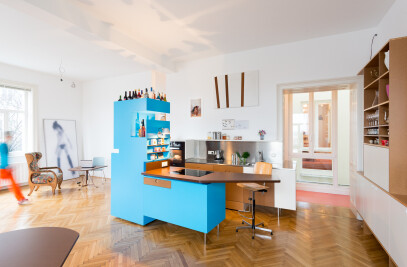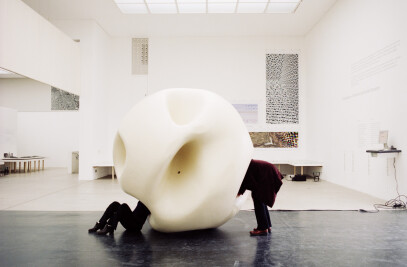Let's start with the location: an industrial area. Trucks move in and out, work is being done. A storage yard and a concrete factory are not exactly watchmaker workshops, they are – or were – rough. The position of manufacturing halls and office containers results from operational planning, urban planning is hardly involved. The location is neither beautiful nor ugly; it's built along functional criteria. (…) The concept for the Blindgänger project, as the authors ambiguously name their work*, proposes a linear space instead of the expected fence (Translator's note: around the cultural workshops). It correctly fulfils the same function (that of separation), but goes on to provide a rich experiential space for the human senses. With the walkway the authors create an access that is also a passage, indicating to the user that they are entering an altered space, now designated for public use. To this extent the curved, cylindrical space is a transformational space, one that can evoke a sense of expectation in the people coming from the banal surroundings. Those that simply pass through experience the space and – via the northern opening – are directed towards the landscape.
The material, well rings of reinforced concrete, is a standard product. It has, however, been employed by the designers in an unusual way. Instead of buried in the earth, the concrete rings have been arranged above ground; not tightly up against one another as would be necessary for a well or a pipeline but with gaps between them. These are less for 'looking through' than to let light flow in. The choice of concrete is an allusion to the earlier use (T. N. of the area as a concrete factory). Light is an essential element of this exciting experiential space. It richly permeates from the outside. Inside, the long corridor space is very bright, the brightness intensified by the white paint on the inner surface. Once it is dark outside, the artificial light seeping through the gaps gives shape and definition to the object over its entire length. The unusual architectural space offers many different walking and usage experiences. It can be used as a space for performing, or, the other way round, as a space for the audience, and may become an integral part in the work of the Kulturwerkstätten (T.N. the cultural workshops).
text source: excerpt from a text, originally published in Architektur & Bauforum No. 206, p. 140-144 author: Walter Zschokke
project team: the POOR BOYs ENTERPRISE – Ernst J. Fuchs, Marie-Therese Harnoncourt, Florian Haydn type: installation client: Gemeinde Hof am Leithaberge / Hof am Leithaberge municipality competition: Sept. 1998 1. Preis / 1st Prize (the POOR BOYs ENTERPRISE) contractor: EFN Baumeisterarbeiten structural engineering: Dr. Dipl. Ing. Karl Heinz Wagner

































